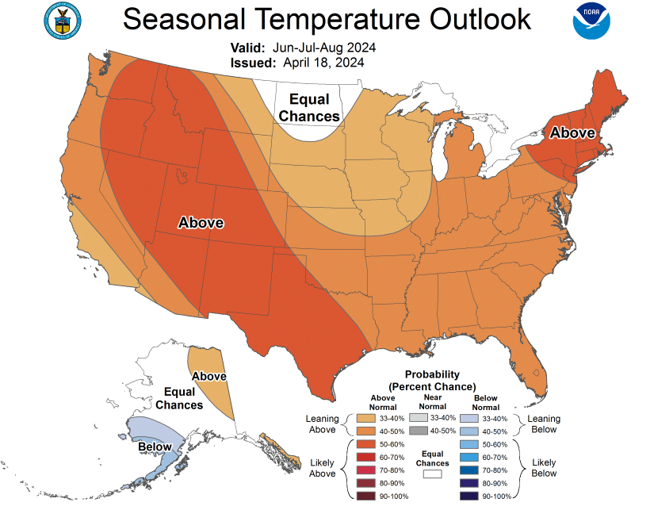Use "MISO" (mEYE-so) in all references to our corporate name.
Email: media@misoenergy.org
Grid Information

The National Oceanic and Atmospheric Administration (NOAA) is forecasting above normal average temperatures for June through August across most of the Continental U.S.. The summer foecast also calls for an active tropical storm season in the Atlantic basin.
MISO projects it will have sufficient electricity supply to maintain power grid reliability. However, during severe or extreme conditions, MISO may implement its emergency procedures to increase the available supply of electricity and/or decrease demand.
In all situations, MISO closely coordinates with its members to manage the electric grid.
Details on the 2024 summer assessment can be found in the 2024 Summer Readiness workshop presentation.
MISO communicates and partners with its members every day to ensure power is flowing and the lights stay on. During abnormal conditions, such as severe weather impacting the grid, MISO operators may need to rely on a set of emergency procedures or "tools" to keep power flowing and protect the bulk electric system. Implementing emergency procedures enables operators to access resources not available under normal grid conditions. These resources include, but are not limited to, reserve and/or emergency generation, importing emergency power, and working with member utilities to reduce power usage. When electricity supply can longer meet demand, the only step available to avoid wide-spread outages, and to protect the system from long-term damage, is to temporarily interrupt power to consumers. This step, known in the electric industry as load shed, is a last resort option and is rarely used.
When it appears electricity supply will be "tight," MISO notifies member operators of what we are seeing, what we expect to see, and what actions operators need to take. MISO posts these notifications on its website at the bottom of the home page. They can also be viewed on the MISO app.
The Grid Conditions gauge on the homepage shows current grid conditions based on available capacity (supply). Movement of the needle from “Green” is triggered by a control room market capacity related notification. The yellow wedge represents alert and warning notifications. The orange and red wedges represent Energy Emergency Alerts.
MISO, as a Regional Transmission Organization, has a specific role to play, and specific "tools" it may rely upon, when it comes to power restoration.
Power Restoration Role and Responsibilities
MISO’s primary role during a power grid restoration in its region is to serve as a facilitator during the restoration process: coordinating, exchanging information, and maintaining stability.
MISO is responsible for the collection and exchange of information, as well as communication and coordination with the impacted entities. Additionally, MISO is responsible for working with our impacted members to coordinate getting the power flowing again across the grid while maintaining stability so as to prevent a re-collapse of the system.
MISO also coordinates with its neighbors to ensure stability throughout the restoration process.
Restoration "Tools" or Procedures
MISO operators can rely on a number of emergency procedures to ensure grid stability and reliability during restoration. These "tools" can include sending emergency notifications and declarations to member operators in the MISO region. Some of the notification and declarations that could be issued include:
- Transmission Advisory
- This communication tool is used for situational awareness. The message informs members that, based on projected system conditions, there may a transmission issue that will require specific actions to be taken in order to ensure reliability.
- Local Transmission Emergency
- This declaration identifies a specific entity or entities and provides instructions for mitigating a transmission emergency for a specific area of the grid
- Transmission System Emergency
- This declaration provides instructions for mitigating operating emergencies on the Transmission System that have the potential to exceed a pre-defined system operating limit that could lead to instability or outages.
The electrical grid is an interconnected network for delivering electricity from producers to consumers. It consists of generating stations that produce electrical power, high voltage transmission lines that deliver electricity to sub-stations, and distribution lines that deliver power to homes, schools and business.
As a grid operator, MISO's role is to ensure the right amount of high-voltage electricity is generated and transmitted safely and reliably to our member utilities. MISO does not own any equipment on the bulk electric system. Our members do. It is the local utilities who are responsible for delivering electricity safely and reliably to their customers.
Learn more about MISO and the Electric Industry on our Industry Foundations page.
MISO's Responsibilities
MISO is a Regional Transmission Organization (RTO) responsible for doing three things:
- Managing the generation and transmission of electricity across high-voltage lines located within its region
- Managing the buying and selling of electricity within its region
- Planning the MISO region grid of tomorrow
MISO's role and responsibilities can be compared to those of an air traffic controller. Air traffic controllers are responsible for ensuring planes get from point A to point B safely and reliably 24/7/365. They don't own the planes, they don't own the runways, they don't own the terminals. They simply manage the movement of planes.
MISO manages the movement of electrons across the bulk electric system in its region 24/7/365. From generation to transmission. MISO does not own the generators, the transmission towers, or the transmission lines. Our members do.
MISO makes sure the right amount of electricity is generated and transmitted to our member utilities who are responsible for delivering the power to their customers.